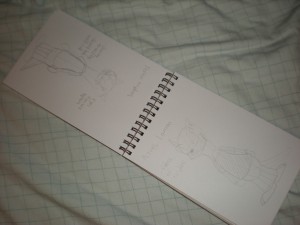This post is the first part in a series I’ll be doing through this month and probably into March about how to make a comic. I’ll cover pencilling, lettering, and inking as well as some of the other subjects involved.
Before you can make a comic, there’s something you need. What is it? Pencils? Pens? A T-square? A twenty pound can of beans? No! You need first and foremost…an idea! But where do you get ideas for making comics?
I talked about this before in the past. I learned from video game programmer Howard Scott Warshaw that ideas are something that you get. You find them. So where do you find ideas? Why, look all around you. You can find ideas anywhere. Hmm, that sounds a bit vague. Maybe I’d better expand on that. Some of you may choose to read your favorite comics (comic strips, manga, the latest cutting edge alternative graphic novel your fellow hipsters are reading, etc) as a starting point. There’s nothing wrong with that – but limiting yourself only to comics is a BIG mistake. You can only recycle what has been already produced. In this case, you should follow a rule that many prose writers do – read outside your genre. Try surfing the web for blog posts and articles. Mosey on down to your local newsstand and browse through the newspapers and magazines. Swing by your local library and do some research. A trip to your local bookstore can do wonders. You never know…one of these trips could spark an idea. Of course, you’ll need a way to capture those ideas. Take a camera with you and snap photos of places, people, and things. You can also do what I do and take a tape recorder (or digital audio recorder).
 Take one of these with you where you go. If you think of an idea, you can capture it on tape. Think of all the ideas you can cram onto a sixty minute or thirty minute tape. Yes, there’ll be times where you just talk into it and say “uhhhh…” or “ummmm…” Sometimes you say something strange or ridiculous. But it serves to capture ideas. Another must-have tool for getting ideas is to take a small sketchpad or a notepad with you wherever you go.
Take one of these with you where you go. If you think of an idea, you can capture it on tape. Think of all the ideas you can cram onto a sixty minute or thirty minute tape. Yes, there’ll be times where you just talk into it and say “uhhhh…” or “ummmm…” Sometimes you say something strange or ridiculous. But it serves to capture ideas. Another must-have tool for getting ideas is to take a small sketchpad or a notepad with you wherever you go.
 I take a small pocket sized sketchpad with me so I can scribble down ideas I think for characters to use in Sunnyville Stories. You can do this too with a notepad. If you think of a weird plot like “giant purple bunnies arrive on Earth to steal ammonia”, you can write it down. In fact, it’s important to write down or sketch your ideas. It’s very easy to lose them. You don’t know how many ideas I’ve ended up losing due to forgetting them.
I take a small pocket sized sketchpad with me so I can scribble down ideas I think for characters to use in Sunnyville Stories. You can do this too with a notepad. If you think of a weird plot like “giant purple bunnies arrive on Earth to steal ammonia”, you can write it down. In fact, it’s important to write down or sketch your ideas. It’s very easy to lose them. You don’t know how many ideas I’ve ended up losing due to forgetting them.
What other ways can you generate ideas? Well, there is the old adage “write what you know.” You can draw upon your own personal experiences for making a comics. You could make up a short comic strip about the time you burned your lunch. You could make a longer story about that time you spent all day in line at the DMV. You could create a series about your experiences at a new school or in a foreign country. This has been done before. For example, I talked about how part of my comics series was based on my moving down to the southern USA in the Origins of Sunnyville part 1. Peter Kuper is another example; his graphic novel “Diario de Oaxaca” was based on his own trip down to Mexico in 2006. (Check out more info about that book here at CBR.) Art Spiegelman based his award-winning graphic novel Maus on the stories his father told him about living through World War II and the Holocaust.
Here’s another idea – “borrow” one. Watch a movie, take a look at a TV sitcom, read a book, etc. If you see a plot in there with potential, why not take another spin on it and make it into a comic? There’s nothing wrong with some judicious borrowing from here and there. For example, Terry Brooks’ inaugural novel The Sword of Shannara is basically Lord of the Rings with elements of adventure novels thrown in. Steven Spielberg’s 2001 film A.I. is essentially Pinocchio with robots replacing puppets. Even the Star Wars saga is derived from Buck Rogers, Flash Gordon, and Akira Kurosawa samurai films. I’ve done it myself – the inspiration as well as the look and feel for Sunnyville came from the 1986 anime series “Maple Town” as I explained in the Origins of Sunnyville Part 2.
Another way to generate ideas is one I’m going to borrow from the Surrealist painters like Dali, Magritte, and Miro – free association. Trying saying a sentence, word, or phrase off the top of your head…anything that pops in there and then write down whatever it is.
Those are just some suggestions to get you started. Ultimately the ideas you want and the stories you make from them – it’s all up to you. If you need some additional help…well, next Wednesday, I’ll have a list of 101 comics ideas you can use for inspiration. I’ll also ask you out there – where do you find your ideas? Feel free to tell me as I might use your suggestions in a future post.
Until next week, friends. Please comment on this post and feel free to ask questions. Subscribe via RSS if you haven’t already and don’t forget to swing by Indy Planet for copies of Sunnyville comics!

Wonderful article, Max.
I find that ideas come to me in 3 places: in the shower, in dreams, and with hands dipped in flour helping Grandma making raisin cookies. There is something special about not having anyplace to write them down that is the key for a great idea.
The shower is difficult to capture because the water keeps washing away the soap I scribble on the wall. Dreams are difficult to capture unless you have a pencil and paper right by the bed waiting to go when you wake up. And even then the ideas are never 100% what you experienced. It leaves your brain almost as soon you begin to write. Baking with flour on your hands is difficult to capture because Grandma doesn’t like flour tracking over her floor when you reach for a pencil.
I have a file called “Great Ideas” and try to write them down, as soon as I can. The best ideas though, will stick to you. It’s those that you don’t have to write down that are the most (productive/dangerous) because you can generally implement them immediately.
The best way I grab an idea for a solution when I am stuck is to really think about it for a good long while. maybe 30-60 minutes or so–until I realize I am stuck with no way out of this mess. Then I let it go. I don’t think about it at all. Then when I’m in the shower, or wake up from a dream, or am talking to Grandma about her raisin cookies–POP–out of nowhere the problem resolves itself in my brain, or offers some other advice to attack a problem. Solution solved. I don’t have to write it down because I can implement it immediately and I’ll remember it.
I’d also suggest you give your ideas away to people who can use them. A person gets too many ideas for their own good. If you can’t implement it to turn an idea into a tangible asset, it’s not doing anyone any good.
Thanks for commenting, Daniel. Check out next week’s post when I actually list 101 comics ideas!
Pingback: How to Make Comics: Thumbnails and Layouts | Sunnyville Stories
hi man i have ideas to but i cant drow
I talk about this in another one of my blog posts, but believe it or not, you don’t need to be able to draw to make comics! Some people make comics using photographs like Jon Gorga or Alien Loves Predator. Some use clip art like David Rees. Some use collage or stencils. Keep in mind that superior writing will always trump weak art, rather than the other way around.
Pingback: Getting Inspiration for Comics | Sunnyville Stories